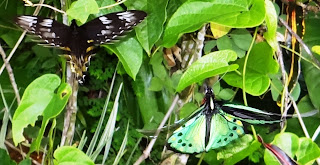This week the largest butterfly in Australia, the female Cairns Birdwing, some 16cm wide, are feasting on the sweet nectar produced by the flowers of the umbrella tree. When the flowers open in the warm summer heat the nectar spills out and overflows dripping from the flowers much to the delight of the butterflies and other insects.
Nature is extravagant with colour and quantity and no where more so than in the Wet Tropics Rainforests of far north Queensland.
Frogs have been calling constantly and crested hawk is hungry and on the hunt. I followed the sound of hawk's call to a look-out tree and I found a female crested hawk perched high on a dead tree branch her high pitched call ke-i, ke-i rang out over the rainforest.
The crested hawk or Pacific baza as it is also named has striking golden eyes surrounded by green skin. The female differs slightly from the male with a browner rump and narrow bars across the tail.

The crested hawk feeds mainly on insects but it will take frogs and mice as well as other small mammals.

As I watched this beautiful bird she suddenly turned her head as if saying, are you looking at me?
.
 With that she spread her wings and took to the sky to hunt over the canopy of the Moresby Range Nationl Park. What a privilege to have such an experience with a wild creature.
With that she spread her wings and took to the sky to hunt over the canopy of the Moresby Range Nationl Park. What a privilege to have such an experience with a wild creature. The latest brood of Agile Wallaby babies are growing fast and are almost ready to leave the pouch. Dad is never far away keeping guard while mum and babe eat the lush new grass shoots.
Agile wallaby babies stay in the pouch for 7 to 8 months. Although these wallabies are known to breed all year many of the females seem to carry off-spring around all the same age in any one group.
I often see family group of between seven and twelve individuals at the end of Coquette Point.
Do you ever get the feeling of the presence of something or someone? I got that feeling very early one morning this week. I was walking down to open the gate and something compelled me to look into the forest where the first rays of light were only just penetrating and there was a Cassowary seemingly sound asleep. He quickly woke and stood up.
In the gloom I saw the cassowaries eyes open with large dilated pupils, it was 'Snout'.. He did not move as he watched me. On the ground I noticed a scrape where the leaves had been pushed aside this had been his bed for the night.
Melaleuca leucadendra trees are in flower all through the swamp. The sickly-sweet smell of their nectar is carried on the hot humid air.
In the melaleuca trees rainbow lorikeets jostle and fight over the sweet nectar.
A beautiful dog walked into the nursery on Tuesday wagging his tail he came straight up to me, sat down and barked hello. He was not wearing a collar or any identification.
Martin took a shine to him and called him Rusty. It took some drinking and feeding to get his hunger satisfied. I rang around Coquette Point but no one had lost a dog. I called the Council and the new dog catcher was out within 30 minutes. With gentle coxing and handling Rusty was taken away to the pound.
Coquette Point is often used as a place to dump unwanted dogs. Stray dogs in packs are devastating for shorebirds, cassowaries, wallabies and all other ground creatures which live in this part of the World Heritage Wet Tropics. It was good to see Cassowary Coast Regional Council has an efficient and caring dog catching programme.
cheers for this week,
Yvonne

 aleuca leucadendraMel
aleuca leucadendraMel








 ,
,









































